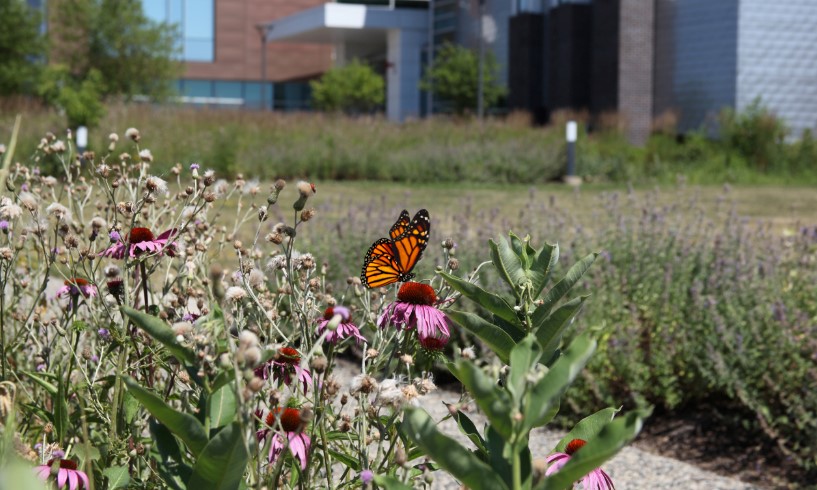Lakeland Community College awarded grant to promote conservation of migratory species
Posted: July 9, 2024 | Updated: July 10, 2024

Through a partnership with the International Programs Office of the U.S. Department of Agriculture Forest Service, Lakeland Community College was awarded a grant to promote the conservation of migratory species through community education, awareness and training.
To achieve this lofty goal, the college has installed a Motus Wildlife Tracking System (Motus https://motus.org) consisting of an automated radio telemetry tower designed to detect radio transmitters affixed to migratory wildlife such as birds, monarch butterflies, dragonflies and bats. The tower works in concert with software and sound recording devices all designed to facilitate research and education on the ecology and conservation of migratory animals.
Due to its proximity to Lake Erie, Lakeland is a key location for installing the Motus radio telemetry tower.
“A station located on the rooftop at Lakeland, a high point in the terrain of Lake County, will enable students to collect data from tagged birds, insects and mammals in the area,” said Michael Rizo, program specialist for the USDA Forest Service International Programs. “The Motus network of towers exists throughout Canada, the United States and Latin America. Using this data, Lakeland students will be able to track migration patterns of species from Northeast Ohio all the way to the Caribbean and Latin America.”
Having a tower at Lakeland will close gaps in the existing Motus network while allowing Lakeland faculty to be part of a large research and conservation collaborative. Faculty working in partnership with the Forest Service International Programs will have the ability to design academic projects around the Motus station and research network for Lakeland students as well as for the greater community including area middle schools and high schools.
“With Lakeland’s strong partnerships and connections with local schools, it is exciting that we will be able to make migration science accessible to members of the community,” Rizo added. “Lake County is an important place along the flyway of migratory birds and monarch butterflies.”
In addition to the installation of the Motus tower, this grant includes professional development programs for Lakeland faculty and area middle and high school teachers; as well as enhancing student education about migration and how changes impact ecology, climate, our environment, and economic development. Lakeland plans to achieve these objectives through a variety of program offerings.
“With this project we envision workshops for college faculty and classroom teachers at the middle and high school level. We have already hosted workshops for the past two summers,” said Dr. Erin Fekete, dean for arts and sciences at Lakeland. “For our students, our goal is to create experiential learning opportunities through internships and hands-on science labs that integrate real-world applications of migration science and conservation biology, like bird banding.”
To encourage migration and conservation along with education for students as well as community members, the grant also includes funding to create native habitat demonstration gardens on Lakeland property.
“We are excited to have native plants in the demonstration garden that will include host plants and nectar sources for monarchs and other pollinators. The integration of trees native to the region that provide stopover sites for migratory birds might also be included,” said professor of biology Dr. Justin Rosemier. “These demonstration gardens will provide hands-on labs and learning exercises for our biology, ecology and other science faculty and students.”
Lastly, the grant calls for Lakeland and the Forest Service International Programs to develop a community education and awareness program. The Forest Service International Programs will work with Lakeland and other conservation partners to offer annual events for community members to increase education on species migration and the role of the MOTUS station. Events will include bird, butterfly and dragonfly migration.
Once the data is collected, it will be shared extensively through on-site educational hubs at Lakeland as well as through community education and awareness programs with the Forest Service International Programs and other conservation partners. Data can also be shared with land managers to influence the conservation of habitat in strategic areas of Northeast Ohio.
By: Levi Rex, Marketing Communications Specialist
lrex1@lakelandcc.edu
440.525.7507
